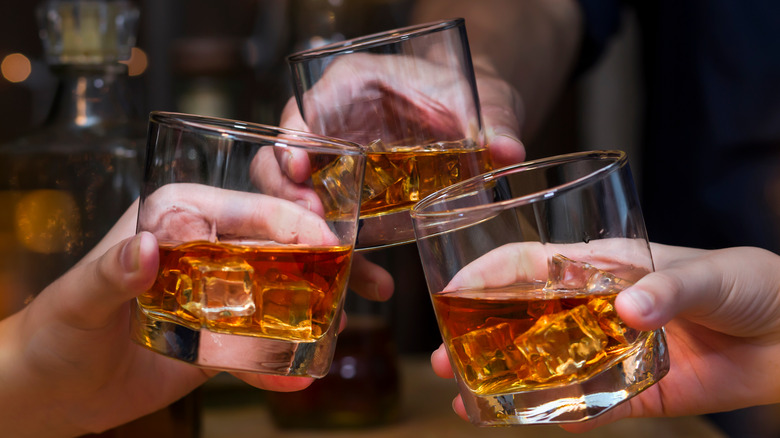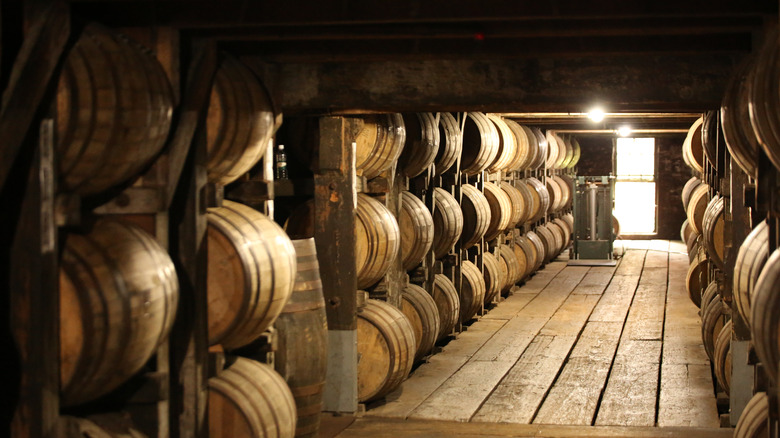Sourced Bourbon Is Actually Worth Your Time. Here's Why
For bourbon purists, it might be time to get off that spirited high horse and join the throngs of whisky lovers embracing the wave of sourced bourbons. Just because the bourbons aren't directly distilled by the entity selling them doesn't mean they're second-class whiskey products — not anymore, at least. Known by various monikers, including MGP or blended bourbons, sourced whiskeys are subjectively rivaling major and small-craft distillers when it comes to pouring quality. After all, what's in the cup and on the tastebuds is what ultimately matters.
Sourced spirits, including bourbons, refer to the growing number of bottles bearing liquids distilled at one source and sold by another. What happens along the way distinguishes the brands from others doing the same thing. The new offspring products have ties to the original distiller but with intriguing twists and the sometimes-surprising flavor turns. Since they're likely here to stay, sourced bourbons are worth exploring.
The nuances of sourced bourbon
Though sourced bourbon can theoretically come from any distiller, most originate at the Midwest Grains Products (MGP) distillery in Lawrenceburg, Indiana (via Liquor Laboratory). Buyers, typically new or small whiskey brands, can purchase the liquid "as is" in bulk and bottle it with their unique labels or be more involved.
Using a contract method, buyers can influence the outcome by specifying the distillation time and the composition of the "mash bill," which refers to the percentages of ingredients, typically malted barley, rye, and corn. Then there's the blended approach, in which the purchasing brand uses sourced bourbon to supplement its own in-house distillations or create an entirely new blended brand with varying characteristics. This is arguably where the end consumer experiences the most nuanced spirit flavors, subject to the expertise of the blender.
The "master" designation in the world of bourbon isn't reserved solely for distillers — it's the master blender who balances sourced bourbons to achieve a delicate balance based on factors such as distillation ages, barrels, alcohol by volume (ABV), and corn/grain content. Consequently, using sourced bourbon, the blender creates entirely different tastes that become the signature products of new or existing brands.
Recognizing sourced bourbon
So how do you go about tasting the wide array of sourced bourbons available today? Locating them is not as straightforward as you'd think. Regulations are a bit fuzzy, with marketing terms often fueling perception. Even if a bourbon identifies as "handcrafted" or "small batch," that doesn't mean the maker distilled it.
The best way to recognize a sourced bourbon is to look for a phrase on the bottle label indicating where it's distilled or produced — although this isn't as clear-cut of an indicator as it should be since these can be mixed up from time to time, depending on the company. Most bourbon gets distilled in Kentucky, so it will likely reveal that in its "distilled by" declaration. A "distilled in Indiana" declaration could mean that it's a sourced bourbon since many of them come from MGP or other sourcing companies in the state.
Many well-known bourbons either started with blended whiskey or occasionally supplemented their supply that way. For example, NBC News reveals that Bulleit "Frontier" Whiskey originally sourced most of its bourbon from the MGP distillery before transitioning to its distillation in Kentucky. In the broader category of overall whiskeys, which includes bourbons, the widely acclaimed Uncle Nearest brand has garnered 450-plus industry awards, honors, and recognitions since opening in 2017. But its products are primarily contract sourced or blended, at least so far.
Think of a sourced bourbon like a luscious gourmet cake; just because the baker didn't grind the flour doesn't mean the cake is anything but gorgeously delicious.


